Hiking Adventure on the Kyoto Trail!
Whether you’re a beginner or seasoned hiker, the “Kyoto Trail” is one of the best experiences Japan has to offer. This 132km (82 mile) long path encircles the ancient capital of Kyoto, affording incredible views of the city, Lake Biwa and more.
Let’s check out a stretch of the Kitayama Course by train and on foot to discover Enryaku-ji Temple, Kurama-dera Temple, Kifune Shrine and other sights.
Use this handy train route map to check the station nearest to the spots you want to visit. (“Station Number” listed for convenience).
- Details:
-
Hiking Northeast From Kyoto Station to Kurama-dera Temple and Kifune Shrine
Set out from Nidec Kyoto Tower in front of Kyoto station, hop on the Keihan main line and take in a view of the Kamo River. You’ll transfer directly through to the Eizan line, which takes you on to northeastern Kyoto. From Kurama-dera Temple to Kifune Shrine, color your hike with the cherry blossoms of spring or the fiery hues of autumn.
- Points of Interest:
- Nidec Kyoto Tower, Kamo River, Eizan train line, Kurama-dera Temple, Kifune Shrine, riverbed

Nidec Kyoto Tower
Why not enjoy some shopping and eating before or after your hike? This spring, the newly renovated commercial floors of the KYOTO TOWER SANDO building reopen. Your mouth will water as you peruse the basement food hall. Have a coffee break and pick up some souvenirs on the 1st floor. The 2nd floor offers all new sushi and confectionary-making workshops.
And don’t forget to stop by the 3rd floor tourist information center. This is where you can purchase rail passes, arrange accommodations, and of course obtain valuable info for your hike. Get into hiking mode with a 12-minute walk from Kyoto station to Shichijo station on the Keihan main line.
- Access:
- 3 minutes on foot from Kyoto station
- Details:
-
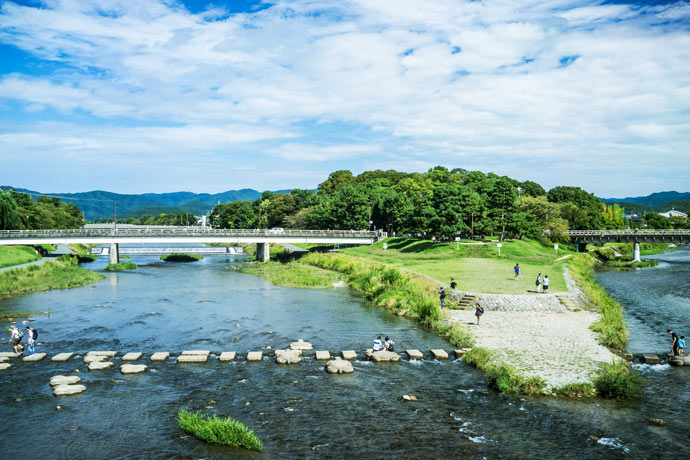
Kamo River
From Shichijo station (KH37) it’s only an 8-minute ride on the express to Demachiyanagi station (KH42). You’ll want to make your first stop here to enjoy a stroll along the Kamo River and view the lush green mountains of Kyoto in the distance. The Kamo River Park delta, where the Kamo and Takano rivers converge, is a prime cherry blossom viewing spot from late March to Early April. Also a popular viewing locale for the spectacular Daimonji festival every August 16th.
- Access:
- 3 minutes on foot from Demachiyanagi station (KH42)
-

Eizan Train Lines
Get back on the train at Demachiyanagi station and take the Eizan Kurama line’s “Kirara” scenic car, complete with sofas and big windows! In the autumn, take a night train through the “momiji” (Japanese maple) tunnel between Ichihara and Ninose stations. It’s a spectacular display of illuminated fall colors.
- Details:
-

Hiking Route from Kurama-dera Temple to Kifune Shrine
From Kurama station to Kurama-dera Temple, on to Kifune Shrine and lastly Kibuneguchi station is approximately 4.5km (2.8 miles) for a 90-minute hike. Wear good shoes for the amazing tangle of cedar tree roots you’ll come across on the old mountain path (300 yen to enter). If you go through the west gate of Kurama-dera Temple you’ll see the Kibune River and Kifune Shrine up ahead. In the summer, you can enjoy “kawadoko” dining – you sit cross-legged on a platform built directly over the Kibune river flowing beneath.
 Kawadoko
Kawadoko
-
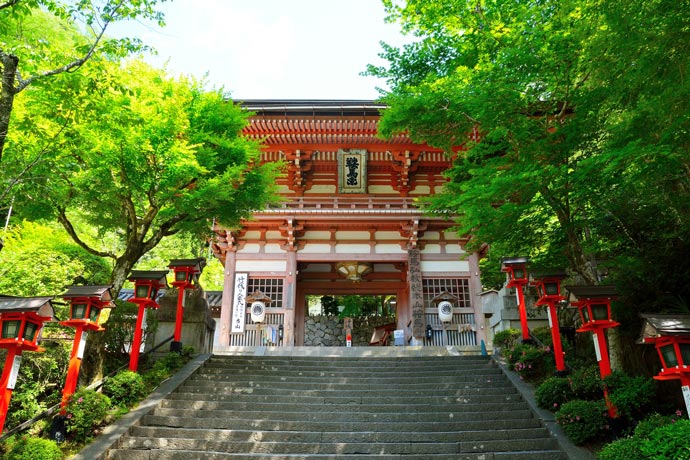
Kurama-dera Temple
Kurama-dera Temple is famous as the place where early 12th century military commander Minamoto no Yoshitsune (then named Ushiwakamaru) was raised after his father and older brothers were killed.
Legend has it that Ushiwakamaru encountered a “tengu”—a mythical creature that lives deep in the wilderness, flies, and has supernormal knowledge—during his training in the wilderness, and was taught the art of swordsmanship. Aside from the temple, nearby Kurama Hot Spring is a popular day trip destination.
- Access:
- 25 minutes on foot from Kurama station (E17) or by cable car
-

Kifune Shrine
The headquarters for approximately 500 Kifune shrines across Japan, the deities of water have been enshrined here since ancient times.
Known for its water festival every July 8 and “mizuura mikuji” paper fortunes.
* The date changes every year.
- Access:
- 30 minutes on foot from Kibuneguchi Station (E16), or by Kyoto Bus.
- Details:
-
Hike Through Breathtaking Scenery From Enryaku-ji Temple to Lake Biwa
Our next Kyoto adventure starts out at Demachiyanagi station (KH42), riding the Eizan train line, followed by cable car and finally ropeway (aerial tramway) to the UNESCO World Heritage site of Enryaku-ji Temple on Mt. Hiei. Take in the picture-perfect scenery of Lake Biwa on the return journey. It’s not possible to see everything in one day, so select two or three of the following spots to plan your hike:
- Points of Interest:
- Garden Museum Hiei, Enryaku-ji Temple, Hiyoshi Taisha Shrine, Sakamoto district, Lake Biwa “Michigan Cruise,” Lake Biwa canal viaduct, traditional cuisine at Kamo River riverside restaurants

Hiking route from Mt. Hiei to Sakamoto
This 6.7km (4.2 miles) ancient pilgrimage route offers a dynamic three-hour trekking experience through undisturbed natural scenery. Set out from the Hiei cable car station and walk the trail until Enryaku-ji Temple East Tower. From there, descend along the main hiking route until you reach Keihan Sakamoto station in neighboring Shiga Prefecture.
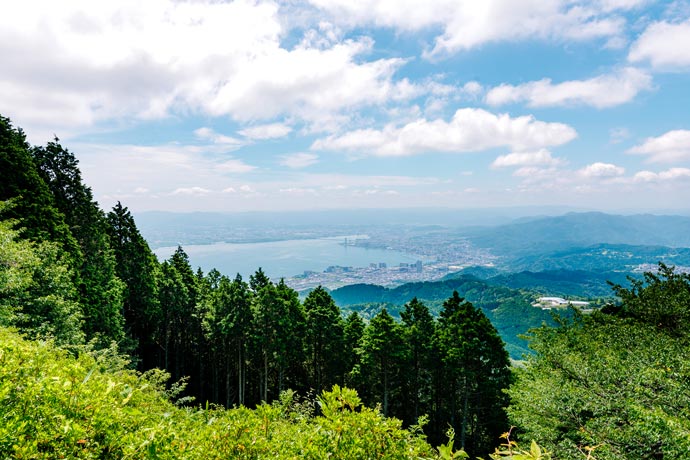
-
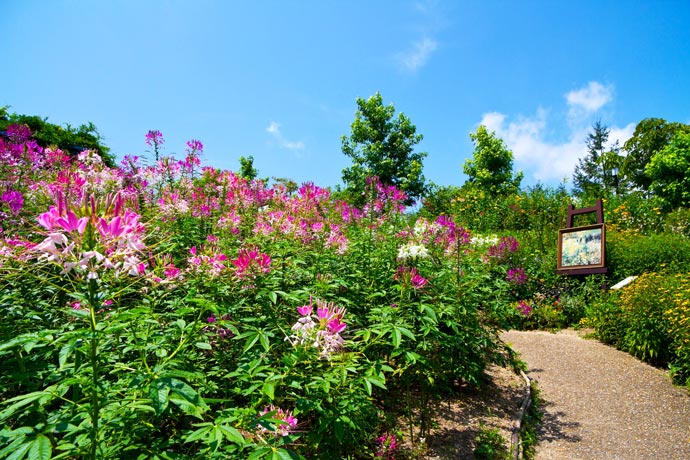
Garden Museum Hiei
If your schedule allows, stop in at the beautiful Garden Museum Hiei. Located at an altitude of 840m (2756 ft.), the museum boasts a French-influenced floral spectacle of over 10,000 flowers of 1,500 varieties. The stunning panorama of Lake Biwa will energize you for your hike.
- Access:
- 2 minutes on foot from Hieizan Ropeway station
-

Enryaku-ji Temple on Mt. Hiei
Buddha of Healing statues in Enryaku-ji Temple East Tower. The flames in the main hall – “The Eternal Lights of Buddhism” – have remained constantly lit for 1,200 years. A sublime sightseeing experience.

A walk through the terrain of Mt. Hiei, which spans both Kyoto and Shiga prefectures. Enryaku-ji Temple (Mount Hiei) encompasses some 150 buildings in three main areas of the mountain – the East Tower, the West Tower, and the Yokogawa area. Inside are stored numerous national treasures and works of art. Many notable monks studied at Enryaku-ji over the centuries, some going on to found different sects. This temple is imbued with history.
- Access:
- 30 minutes on foot from Hiei Sancho Station, or 6 minutes on the Hieizan shuttle bus
-

Hiyoshi Taisha Shrine
After paying respects at Enryaku-ji Temple, walk back to the Sakamoto cable car and descend toward the southern tip of Japan’s largest lake, Lake Biwa. Not far from the cable car terminus is Hiyoshi Taisha Shrine, head of approximately 3,800 Sanno shrines across Japan. Autumn is the best time to visit, with over 3,000 trees colored blazing red and orange. The best season for walking in Sakamoto district is late March to early April.
- Access:
- 7 minutes on foot from Sakamoto cable car stop. 10 minutes from Keihan Sakamoto station (OT21).
-

Michigan Cruise
After your hiking adventure is finished, why not relax on the scenic “Michigan Cruise” on Lake Biwa? From Keihan Sakamoto station take the Keihan Otsu line approximately 15 minutes to Hamaotsu station. Enjoy lively music and good food, with a fantastic view of the entire lake from the upper deck. The cruise lasts 80 minutes.
- Access:
- 3 minutes on foot from Hamaotsu station (OT12)
- Details:
-

Lake Biwa canal viaduct
125 years ago, the Lake Biwa canal viaduct was constructed to carry water from Lake Biwa to the residents of Kyoto. Over a distance of 35km (21.7 miles) the canal continues to provide an irreplaceable source of life, culture and industry to Kyoto. In the spring, cherry blossom trees along the canal are illuminated at night.
- Access:
- 2 minutes on foot from Miidera station (OT13)
-

Kamo River riverside dining
After returning to Sanjo station on the Keihan main line, you can complete your day with a memorable Japanese supper at a riverside restaurant along the Kamo River. Known as “Kamo River yuka noryo,” diners sit on the floor of a terrace overlooking the water as they enjoy the cool evening breeze of Kyoto’s scorching summers. There are approximately 80 such establishments. Recommended season is from May and September.
- Access:
- Vicinity of Sanjo station (KH40), Gion-shijo station (KH39) and Kiyomizu-gojo station (KH38)
- Details:
The Easiest Way to Navigate Kyoto and Mt. Hiei: Mt.Hiei Sightseeing Pass(”HIEIZAN ENRYAKUJI JUMPAI TICKET”)
-
For visitors looking to get the most out of Kyoto and Mt. Hiei, Keihan Railways offers the perfect option. This special one-day pass allows unlimited journeys on all Keihan lines between Osaka, Kyoto, Shiga and includes entry fees to the various sites of Enryaku-ji Temple. Also includes bonus benefits for facilities along the various routes. Don’t go on your hike without it!
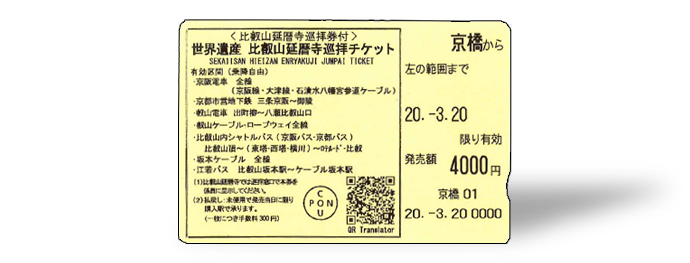
Please check the link below for details on the Recommended Ticket.


